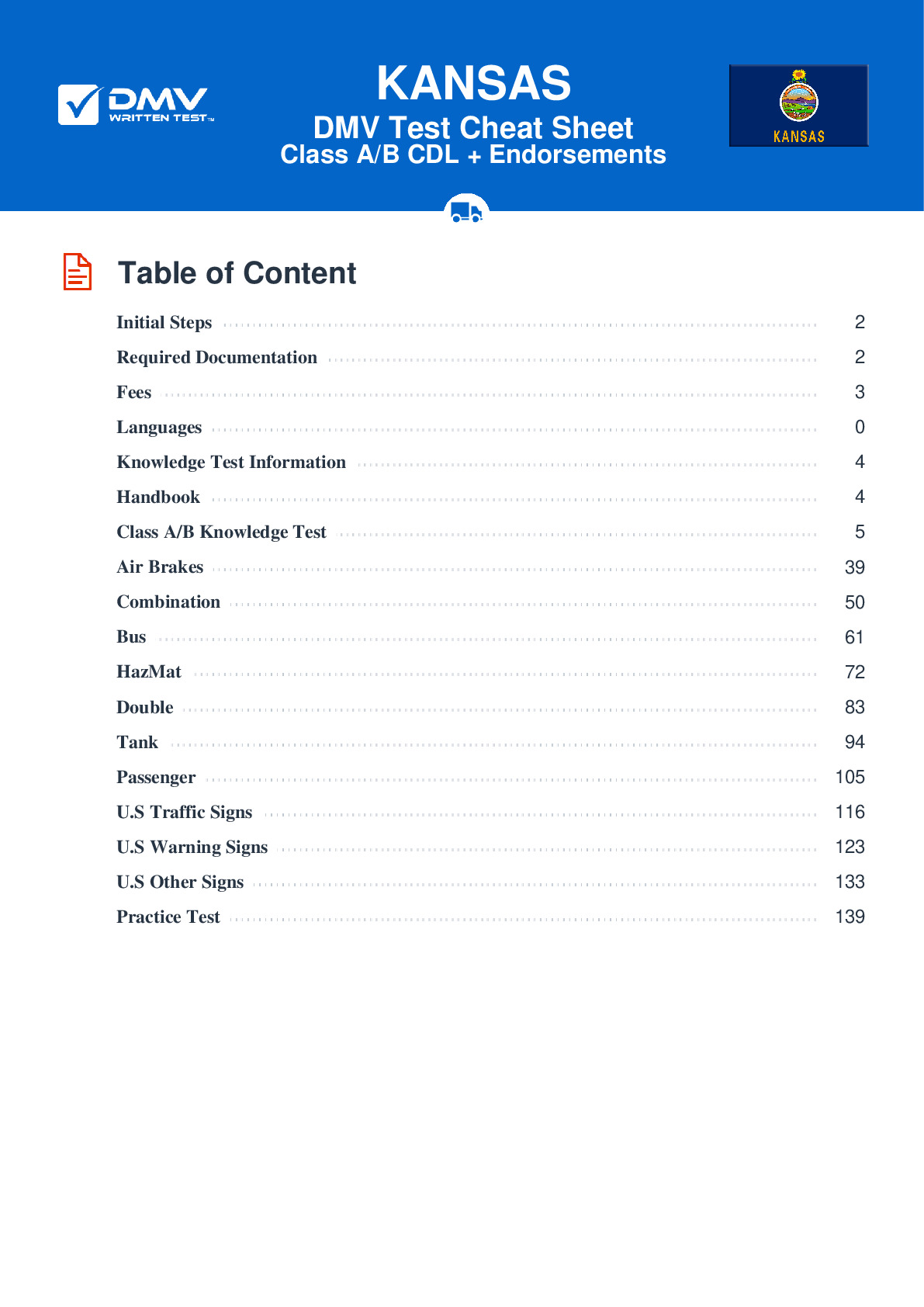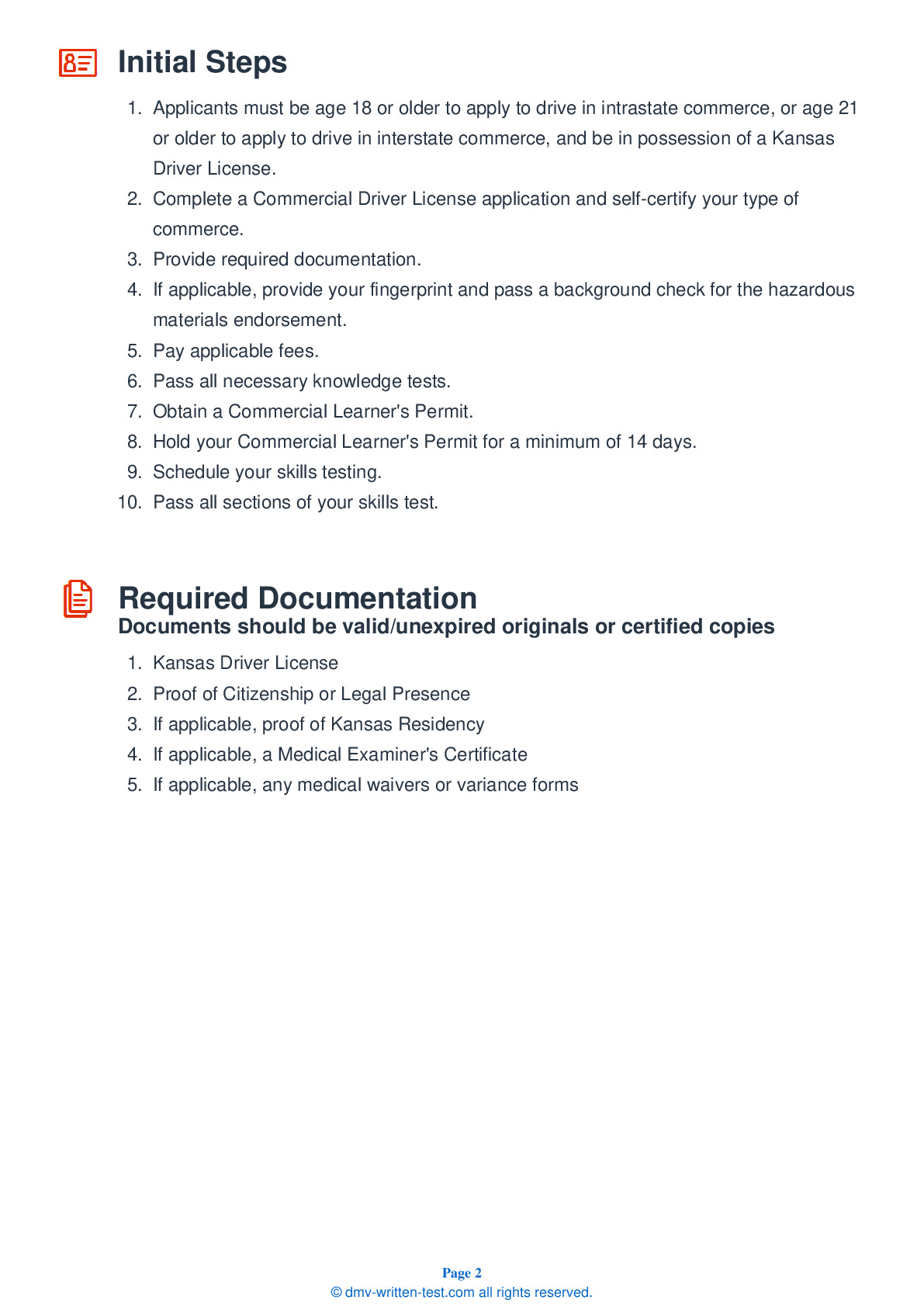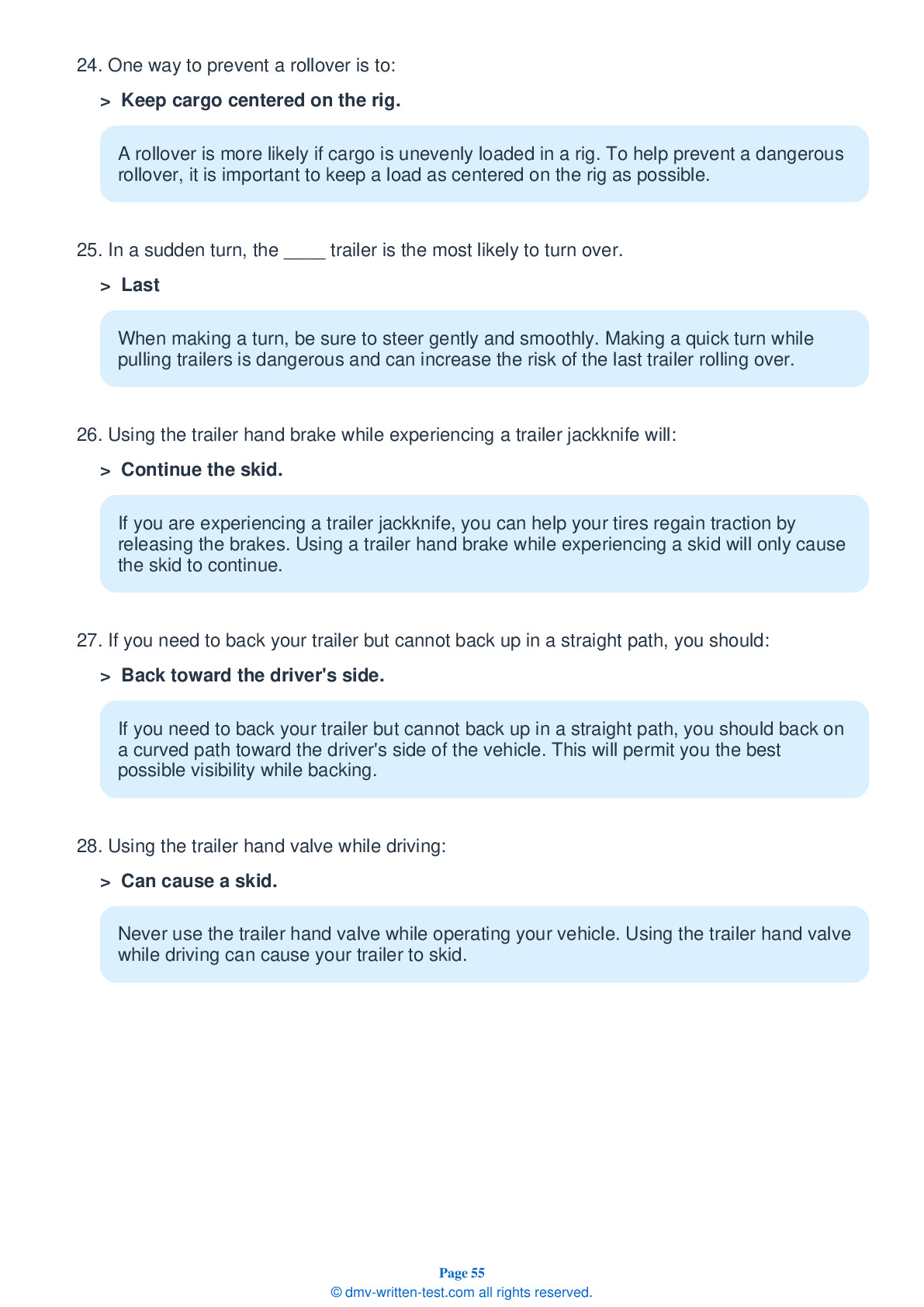Knowledge Test Class B
This license is required for driving a single vehicle with a GVWR of more than 26,001 pounds, and a trailer not to exceed 10,000 pounds gross vehicle weight rating, or a vehicle designed to transport 24 or more people (including the driver). To receive this license, applicants must pass a 50-question test. To pass, applicants must answer 40 questions correctly. Each question has four possible answer choices. Test questions come from the Kansas Commercial Driver License Manual. Questions come from chapters covering: Introduction, Driving Safely, Transporting Cargo Safely, Air Brakes (if applicable), Pre-Trip Vehicle Inspection Test, Basic Vehicle Control Skills Test and On-Road Driving.. Endorsements that may be used with a Class B CDL are: Hazardous materials, Tank, Passenger, HazMat and Tank, Air Brakes and School bus.
1. When driving:
Operators driving too fast is a major cause of fatal crashes. You must continually adjust your speed to a rate that is safe for road and traffic conditions.
2. If exiting a bus during the basic vehicle control skills test, you must:
When exiting your vehicle during the basic vehicle control skills test, you must face the vehicle and maintain three points of contact at all times. If your testing vehicle is a bus, you must maintain contact with the handrail. Exiting the vehicle incorrectly may result in automatic failure of the basic control skills test.
3. If you need to travel down a hill, you should switch into a lower gear:
Always downshift before beginning to drive downhill. Forcing an automatic transmission into a lower gear at a high speed could damage the transmission and also lead to a loss of ability to engine brake. Drive at a speed that will allow you to control your vehicle without overusing your brakes. When determining a safe speed to drive, you should take into account the steepness of the grade, the length of the grade, the weight of your vehicle, road conditions, and weather conditions.
4. If you are turning left and there are two available left turn lanes, which lane should you choose?
A large vehicle may need to swing right to make a left turn. If an intersection has two left turn lanes, the driver should choose the righthand land to begin their turn.
5. The front of an enclosed trailer should:
When inspecting an enclosed trailer as a part of the vehicle inspection test, check the front area of the trailer for signs of damage, such as cracks, bulges, or holes.
6. If asked to sight-side back your vehicle into an alley, you should first:
If you are asked to alley dock, you should first pull past the alley and stop your vehicle in a position that is parallel to the outer boundary. From there, you should back your vehicle entirely into the alley parking area. Your vehicle should be parked in a straight position within the boundaries of the parking space.
7. If a driver begins to feel fatigued while driving, they should:
If you begin to feel drowsy while driving, the only safe response is to safely leave the road and get some sleep. Using artificial stimulants can be dangerous because they may cause extreme fatigue when they begin to wear off.
Frequently Asked Questions
1. Obtain a Kansas Commercial Driver's License Manual from the Kansas Department of Revenue (KDOR) website or any driver licensing office.
2. Meet the eligibility requirements, which include being at least 18 years old, having a valid Kansas driver's license, and passing a medical examination.
3. Obtain a Commercial Learner's Permit (CLP) by passing the written knowledge test at any Kansas driver licensing office.
4. Practice driving with your CLP and a licensed CDL driver.
5. Schedule and pass the Class B CDL skills test, which includes a pre-trip inspection, basic vehicle control test, and road test.
6. Pay the required fees and obtain your Class B CDL license from any Kansas driver licensing office.
7. Maintain your Class B CDL license by complying with all state and federal regulations and periodically renewing your license as required by the KDOR.
1. Single vehicles with a weight of 26,001 pounds or more.
2. Combination of vehicles with a total weight of 26,001 pounds or more but towing a vehicle weighing no more than 10,000 pounds.
Examples of vehicles that you can operate with a Class B CDL license in Kansas include:
- Straight trucks (such as delivery trucks and dump trucks)
- Large buses (such as school buses and city buses)
- Segmented buses
- Box trucks
- Tow trucks (with a gross vehicle weight of 26,001 pounds or more)
- Cement mixers
- Garbage trucks
- Fire trucks (excluding ladder trucks and tractor-drawn vehicles)
- Any other vehicle that falls under the Class B category
1. Age: You must be at least 18 years old to drive within the state of Kansas, and at least 21 years old to drive across state lines or operate hazardous materials.
2. Valid Driver's License: You must hold a valid Kansas driver's license.
3. Medical Certification: You must pass a medical examination and obtain a medical certificate that meets the requirements of the Federal Motor Carrier Safety Administration (FMCSA).
4. Knowledge Test: You must pass a general knowledge test and any other applicable endorsement tests for the type of vehicle you plan to operate.
5. Commercial Learner's Permit (CLP): You must obtain a CLP by passing the knowledge test and paying the required fees.
6. Training: You must complete training with a licensed CDL driver in the type of vehicle you plan to operate.
7. Skills Test: You must pass a skills test that includes a pre-trip inspection, basic vehicle control, and on-road driving test.
8. Background Check: You must pass a background check conducted by the FMCSA, including a criminal history check.
9. Fees: You must pay all required fees for obtaining your Class B CDL license.
Note that additional requirements may apply for specific endorsements, such as hazardous materials or passenger transport.
However, if you plan to drive a commercial vehicle across state lines, you must be at least 21 years old. The age requirement for driving across state lines is set by federal regulations and applies to all states in the United States.
It is also important to note that additional age requirements may apply for specific endorsements, such as hazardous materials or passenger transport.
The following are the endorsements available for a Class B CDL in Kansas:
1. Passenger Endorsement (P): This endorsement is required if you plan to drive a commercial vehicle designed to transport 16 or more passengers, including the driver.
2. School Bus Endorsement (S): This endorsement is required if you plan to drive a school bus with passengers.
3. Tank Vehicle Endorsement (N): This endorsement is required if you plan to drive a commercial vehicle that transports liquids or gases in bulk containers with a capacity of 1,000 gallons or more.
4. Hazardous Materials Endorsement (H): This endorsement is required if you plan to transport hazardous materials, as defined by federal regulations.
5. Combination Tank and Hazardous Materials Endorsement (X): This endorsement is required if you plan to transport both hazardous materials and liquids or gases in bulk containers with a capacity of 1,000 gallons or more.
If you plan to operate a straight truck (a single-unit truck that does not have a separate tractor), you may not need any endorsements. However, if your straight truck is equipped with air brakes, you will need an air brake endorsement (L).
It is important to note that obtaining an endorsement requires additional knowledge and skills testing beyond the basic requirements for a Class B CDL license.
1. Pre-trip Inspection: This is a thorough inspection of the vehicle's components and systems to ensure that they are in good working order and safe for operation. You will be asked to identify and explain the purpose of various parts of the vehicle, including the engine compartment, brake system, steering system, and lighting system.
2. Basic Vehicle Control: This part of the test evaluates your ability to control the vehicle in various situations, such as backing up, turning, and parking. You will be asked to demonstrate your ability to complete a straight-line backing exercise, a 90-degree alley dock exercise, and a parallel parking exercise.
3. Road Test: This part of the test evaluates your ability to operate the vehicle safely in real-world traffic conditions. You will be asked to demonstrate your ability to complete various driving maneuvers, such as making left and right turns, merging onto highways, and navigating through intersections.
During the skills test, you will be expected to follow all traffic laws and demonstrate safe driving practices at all times. You will also be evaluated on your ability to communicate effectively with other drivers and respond appropriately to unexpected situations on the road.
It is important to note that each state may have slightly different requirements for the Class B CDL skills test. Therefore, it is recommended that you consult with your state's Department of Motor Vehicles for specific information about the skills test in your state.
1. Vehicle Weight: Class B CDL drivers are licensed to operate commercial vehicles with a gross vehicle weight rating (GVWR) of 26,001 pounds or more, but they cannot operate vehicles with a GVWR of more than 33,000 pounds. If a Class B CDL driver needs to operate a vehicle with a GVWR of more than 33,000 pounds, they will need to obtain a Class A CDL.
2. Number of Passengers: Depending on the state and the type of vehicle being operated, Class B CDL drivers may be restricted in the number of passengers they can transport. For example, in Kansas, a Class B CDL driver with a passenger endorsement can only transport up to 15 passengers, including the driver.
3. Type of Cargo: Depending on the type of cargo being transported, Class B CDL drivers may be required to obtain additional endorsements or certifications. For example, if a driver is transporting hazardous materials, they will need to obtain a hazardous materials endorsement.
4. Time Restrictions: Some states may have time restrictions on when and how long Class B CDL drivers can operate commercial vehicles. For example, in Kansas, drivers under the age of 21 are restricted from operating commercial vehicles between the hours of midnight and 5:00 AM.
It is important to note that specific restrictions and limitations may vary depending on the state and federal regulations. Therefore, it is recommended that you check with your state's Department of Motor Vehicles for information about any restrictions or limitations for Class B CDL drivers in your state.
In general, the Federal Motor Carrier Safety Administration (FMCSA) requires that all CDL applicants be able to read and speak English sufficiently to understand highway traffic signs and signals, respond to official inquiries, and make entries on reports and records. However, the FMCSA also recognizes that some applicants may have difficulty reading or speaking English due to language barriers or disabilities.
Therefore, some states may offer the CDL written test in languages other than English, such as Spanish or French. In addition, some states may allow applicants to use interpreters during the test. However, these options may come with certain limitations or requirements.
If you are interested in taking the Class B CDL written test in a language other than English, you should contact your state's Department of Motor Vehicles to determine if this option is available and what requirements you must meet.
To request accommodations for the CDL written test, you should contact your state's Department of Motor Vehicles (DMV) and provide documentation of your disability. The DMV will likely require a statement from a qualified professional, such as a doctor or psychologist, describing your disability and the accommodations that are necessary.
Some examples of accommodations that may be provided for the CDL written test include extended testing time, a separate testing room, or the use of assistive technology. However, the specific accommodations provided will depend on your individual needs and the resources available at your testing location.
It's important to note that requesting accommodations may require additional time and preparation, so it's recommended that you contact your DMV well in advance of your scheduled test date. Additionally, accommodations may not be granted if they would fundamentally alter the nature of the test or if they would give you an unfair advantage over other test takers.
In most states, you will be required to wait a certain amount of time before retaking the test. This waiting period can range from a few days to several weeks, depending on the state. You may also be required to pay an additional testing fee when you retake the test.
Before retaking the test, it's important to review the material thoroughly and identify areas where you need to improve. You may want to consider taking a CDL practice test or enrolling in a CDL training program to help you prepare for the exam.
If you fail the written test multiple times, some states may require you to complete additional training or education before you can retake the test again. It's important to check with your state's Department of Motor Vehicles for specific guidelines and requirements related to retaking the Class B CDL written test.




